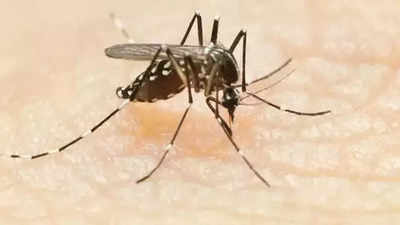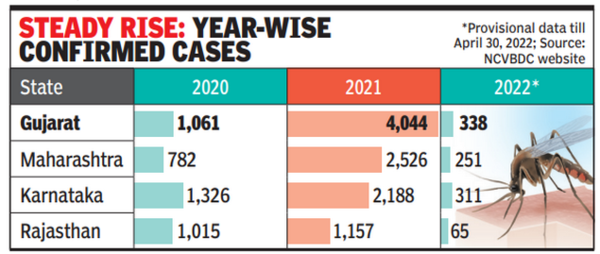- News
- City News
- vadodara News
- Amid Covid battle of Gujarat, chikungunya made inroads
Amid Covid battle of Gujarat, chikungunya made inroads

Image used for representational purpose only
VADODARA: While the state was grappling with the Covid-19 pandemic, agonising chikungunya seems to have made inroads in the state quietly.
Gujarat had the highest number of chikungunya cases amongst all states in 2021 and provisional data for 2022 reveal that the numbers till April reflect a similar trend. The state has been witnessing a steady rise in chikungunya cases after 2019. National Centre for Vector Borne Diseases Control (NCVBDC) data reveals that the number of confirmed cases had come down to 669 in 2019 from 1,290 in 2018. But after this, there has been a consistent rise with 1,061 cases recorded in 2020 and 2,526 in 2021. The trend continued in the first four months of this year too with the state recording the highest number of cases in the country with 338 cases being reported.

Chikungunya fever is spread by the aedes ae-gypti mosquito and is largely a disease that is not life-threatening and is self-limiting. However, it can be painful as joint pain is a common symptom associated with it and the pain can last for quite some time even after a person has recovered.
While the numbers may sound alarming, experts say that they should be taken with a pinch of salt. “The number of detected tests depends on a lot of factors like testing facilities and the efficiency of the public health system, particularly those who work in the field. It is difficult to believe that the state has a higher number of cases than other states which are far more populous,” said an official.
Vadodara Municipal Corporation’s medical officer (health) Dr Devesh Patel said that the higher numbers in the state could be a consequence of a better reporting system and testing. “Our system of collecting and reporting data is improving consistently,” said Dr Patel. An official added that a higher number of detected cases does not essentially mean a higher prevalence of the disease.
Rajkot municipal health officer Dr Jayesh Vakani said that in rural areas the multi-purpose health workers were engaged in combating Covid-19. “It is possible that they could not do anti-mosquito activity efficiently leading to a spike in cases of chikungunya,” he said.
An official in the state health department said that extensive planning had already been done for ensuring vector-borne diseases are kept under control. “Activities to control the diseases have already been started in this direction and we should see the effect by June-July,” said the official.
(Inputs by Yagnesh Mehta in Surat and Nimesh Khakhariya in Rajkot)
Gujarat had the highest number of chikungunya cases amongst all states in 2021 and provisional data for 2022 reveal that the numbers till April reflect a similar trend. The state has been witnessing a steady rise in chikungunya cases after 2019. National Centre for Vector Borne Diseases Control (NCVBDC) data reveals that the number of confirmed cases had come down to 669 in 2019 from 1,290 in 2018. But after this, there has been a consistent rise with 1,061 cases recorded in 2020 and 2,526 in 2021. The trend continued in the first four months of this year too with the state recording the highest number of cases in the country with 338 cases being reported.

Chikungunya fever is spread by the aedes ae-gypti mosquito and is largely a disease that is not life-threatening and is self-limiting. However, it can be painful as joint pain is a common symptom associated with it and the pain can last for quite some time even after a person has recovered.
While the numbers may sound alarming, experts say that they should be taken with a pinch of salt. “The number of detected tests depends on a lot of factors like testing facilities and the efficiency of the public health system, particularly those who work in the field. It is difficult to believe that the state has a higher number of cases than other states which are far more populous,” said an official.
Vadodara Municipal Corporation’s medical officer (health) Dr Devesh Patel said that the higher numbers in the state could be a consequence of a better reporting system and testing. “Our system of collecting and reporting data is improving consistently,” said Dr Patel. An official added that a higher number of detected cases does not essentially mean a higher prevalence of the disease.
Rajkot municipal health officer Dr Jayesh Vakani said that in rural areas the multi-purpose health workers were engaged in combating Covid-19. “It is possible that they could not do anti-mosquito activity efficiently leading to a spike in cases of chikungunya,” he said.
An official in the state health department said that extensive planning had already been done for ensuring vector-borne diseases are kept under control. “Activities to control the diseases have already been started in this direction and we should see the effect by June-July,” said the official.
(Inputs by Yagnesh Mehta in Surat and Nimesh Khakhariya in Rajkot)
FOLLOW US ON SOCIAL MEDIA
FacebookTwitterInstagramKOO APPYOUTUBE
Looking for Something?

Start a Conversation
end of article
Visual Stories
Quick Links

